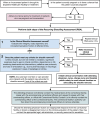Human Rights in Hospitals: an End to Routine Shackling
- PMID: 38169026
- PMCID: PMC11074073
- DOI: 10.1007/s11606-023-08584-8
Human Rights in Hospitals: an End to Routine Shackling
Abstract
Medical students (NSB, NM, JDW) spearheaded revision of the policy and clinical practice for shackling incarcerated patients at Boston Medical Center (BMC), the largest safety net hospital in New England. In American hospitals, routine shackling of incarcerated patients with metal restraints is widespread-except for perinatal patients-regardless of consciousness, mobility, illness severity, or age. The modified policy includes individualized assessments and allows incarcerated patients to be unshackled if they meet defined criteria. The students also formed the Stop Shackling Patients Coalition (SSP Coalition) of clinicians, public health practitioners, human rights advocates, and community members determined to humanize the inpatient treatment of incarcerated patients. Changes pioneered at BMC led the Mass General Brigham health system to follow suit. The Massachusetts Medical Society adopted a resolution authored by the SSP Coalition, which condemned universal shackling and advocated for use of the least restrictive alternative. This will be presented to the American Medical Association in June 2024. The Coalition led a similar effort to coauthor a policy statement on the issue, which was formally adopted by the American Public Health Association in November 2023. Most importantly, in an unprecedented human rights victory, a BMC patient who was incarcerated, sedated, and intubated was unshackled by correctional officers for the purpose of preserving human dignity.
Keywords: hospital policy; human rights; incarceration; restraints; shackling.
© 2023. The Author(s).
Conflict of interest statement
The authors declare that they do not have a conflict of interest.
Figures
References
-
- Lescure T. No Patient Should Have to Die in Shackles. The Washington Post | Opinion. https://www.washingtonpost.com/opinions/2021/10/05/no-patient-should-hav.... Published October 5, 2021. Accessed 12 October 2021.
-
- First Step Act of 2018, United States Congress, Public Law 115–391 S.756, 115th Congress.
-
- Richardson A. Shackling of pregnant prisoners is ongoing. Bill of Health. https://blog.petrieflom.law.harvard.edu/2020/03/04/shackling-of-pregnant.... Published March 3, 2020. Accessed 23 March 2023.
Publication types
MeSH terms
LinkOut - more resources
Full Text Sources


